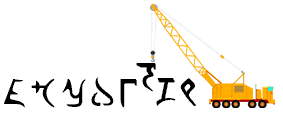 Conlangs
Conlangs
Conlangs A-Z
Conlangs At A Glance
Conlang Directories
Conlang Yellow Pages
Top 100 Conlangs
More Questions? Contact me.
Speak in Lojban Finally, a language that makes sense to humans (and robots)! www.lojban.org |
condir_experimental
© 1996-2004 Jeffrey Henning.
Conlang Directory: Experimental
- Alpítin
- Alpítin Talshäyatyam (literally, the language of the people) is a conlang I have worked with on and off for about six years. It started as an experiment in making a calender for a civilization with a duodecimal number system. Then I played with a way to reflect power relationships through a system of grammatical gender. Eventually I filled out the vocabulary during the bus commute to work. I am still tinkering with it periodically. The following is my translation of the Babel text, with an English equivalent. [Lauren Tantalo]
- Intermythic English
- This failed experiment involved adding a few hundred words to English based on many mythologies, as a slang or simple code (e.g., Nar from Narcissus for the first-person pronoun, Centaur for "ride a horse" or "equestrian"). Thank the gods there's no Babel Text for it [Jeffrey Henning]
- kimwa lilyeho
- Part of the ConlangEvolutionExperiment. A third-generation descendent of Kingiga, via Kingfa and Kimva, kimwa lilyeho is beginning to show signs of fusion in its morphology. [Alex Fink]
- Kinfa
- Kinfa is a second-generation descendant of Kingifa, via Kingfa. It is the first second-generation language in the Conlang Evolution Experiment. [Sven Lotz]
- Kingfa
- The first descendent of Kingifa to be published, Kingfa is part of a conlang evolution experiment. [Apollo Hogan]
- Kingifa
- Kingifa is the starting point of a conlang evolution experiment. It is intended as the common ancestor from which a family of languages will be derived. [Pete Bleackley]
- LáAdan
- Elgin, noted author of The Gentle Art Of Verbal Self Defence series of books, created LáAdan as an experiment to test the Sapir-Whorf hypothesis. Specifically, she felt that English and most natural languages were better suited for expressing the views of men than women. She designed LáAdan to enable women to better give voice to their viewpoints, and the lexicon of LáAdan, more than any other constructed language, has many unique concepts that are expressed in LáAdan in one word but cannot be easily expressed in natural languages. Elgin included LáAdan in her Native Tongue science-fiction trilogy. Unfortunately, little of the language has been documented on the Internet. [Suzette Haden Elgin]
- Vônánà
- Vônánà has many more vowels (24) than consonants (12). It makes much use of diacritics in order to show the different vowel sounds. Vônánà was created as an experiment to see how such a language would look and sound. It contrasts with 'Lt'r, its 'sister conlang' (in that the two were created together), which has many consonants but very few vowels. [Curlyjimsam]
- Wasabi
- In 2002, I ran an experiment at UC Berkeley, in which I got about 20 people together (their names are listed above), and gave them a list of about 300 basic words with a made-up phonology and no grammar, and instructed them to speak using only those words. The result, I hoped, would be some sort of pidgin, which might resemble what a real-life pidgin in its earliest stages might look like. As far as I know, this hasn't been done before. If anyone's heard of a similar experiment, I'd love to hear about it. [Mari Bandoma, Deise Benítez, Allison Buckley, Pablo Cabrera, Marc Callado, Patrick Chan, Charles Chang, Sarah Choi, Lizzy Ghedi-Ehrlich, Julie Gutiérrez, Norma Guzmán, Helen Khlystova, Jason Lin, Tom Nosewicz, Miriam Ochoa, David J. Peterson, Chris Ramiro, Michael Rivera, Adam Simpson, Amy Soong]
9 languages listed.
Updated on January 11, 2005 at 8:14 AM (GMT-5).


